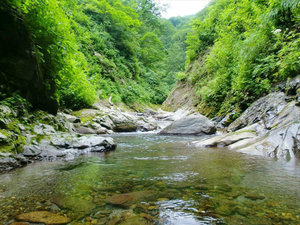Advertisement
Published: March 20th 2014

 Shirakami-Sanchi
Shirakami-Sanchi
Beautiful nature which is same as ancient times still remains.The Tohoku region is the northernmost part of Honshu, which is the mainland of Japan. In the region, six provinces are included; Aomori, Akita, Iwate, Yamagata, Miyagi and Fukushima. There are the Sea of Japan to the west of the region, and the Pacific Ocean to the east. The Ou Mountains, the spine of the region run about 500 km from north to south, through the six provinces. The mountain chain is constituted of 1000-2000 meters mountains, which includes some volcanos. The climate in Tohoku region is separated into two types by the Ou Mountains, the western part is cooler and wetter, has much snowfall in winter, and the eastern is warmer and drier.
The Tohoku region is full of tourist attractions, especially its nature. Also you can enjoy the harmony of nature and history/culture. There are two world heritage sites designated by UNESCO, one is the nature heritage, Shirakam-Sanchi in Aomori and Akita, which is an extensive mountain range that maintains a primeval beech woods. To preserve the virgin forest there is no development or construction, and tourists need to apply to enter the mountains. Shirakami-Sanchi is greatly appreciated globally because of its

 Konjiki-do (Golden Hall), Chuson-ji Temple
Konjiki-do (Golden Hall), Chuson-ji Temple
Konjiki-do, or "Golden Hall" has kept its beauty since 1124, when Chuson-ji Temple was first constructed. It is covered with gold as its name implies.unspoiled condition. Also, its diverse ecosystem is one of the reasons to be rated high. Some protected species such as Japanese serows, and endangered species such as golden eagles are living there too. There are many rules tourists have to keep when entering there not to destroy the environment, but still you will be impressed by its beautiful nature and the magnificent view. The other UNESCO site is the cultural heritage, Hiraizumi in Iwate, which is a Buddhism archaeological site with temples and gardens. Hiraizumi itself is a name of the city, where Oshu-Fujiwara Clan had governed for about 100 years since 1087. The founder, Kiyohira dreamed to build a peaceful town based on Buddhism, and constructed Chuson-ji Temple. After he died, his dream was handed down to his descendants, and they developed the town further. Some temples and gardens constructed at that age no longer remain because of the fire, but still now,
Hiraizumi attracts people as a historical Buddhist destination.
The all six provinces in Tohoku hold famous festivals in early August, tens of thousands of people visit and enjoy those festivals. The three biggest festivals in Tohoku

 Akita Kanto Festival
Akita Kanto Festival
People parade holding "Kanto," which is bamboo pole with many pepar lanterns. This festival is cerebrated to pray for a huge harvest, and also has meaning of protect against evil.consist of Tanabata Festival in Sendai, Miyagi, Nebuta Festival in Aomori, and Kanto Festival in Akita. All of them are related to Double Seventh Festival, which have been celebrating for over 70 years. Hanagasa Festival in Yamagata, Sansa-Dancing Festival in Morioka, Iwate, and Uneme Festival in Koriyama, Fukushima are also representative festivals of respective provinces. In these festivals, local people in traditional clothes parade with dancing through the city with various festival cars. Why don’t you come and enjoy this most exciting festival season?
The Tohoku region got serious damage more than any other regions in Japan on 11 March 2011, when the devastating earthquake had happened. After that disaster, the number of tourists once dramatically decreased, but now it’s increasing slowly. Though the cities and their tourism industry in Tohoku are gradually recovering, many tourists still hesitate to visit those provinces. It is true that many people are yet worried about the series of effects of the earthquake, tsunami and accidents at Fukushima Nuclear Power Plants. Moreover, the impacts brought by the calamity also diminish tourists to cities which didn’t suffer any actual loss to tourism business from the earthquake. To fully

 Sign of safety area for Tsunami
Sign of safety area for Tsunami
It shows the safety area for tsunami both in Japanese and English with a picture. It's easy to understand for travelers who don't understand Japanese language. restore the Tohoku tourists, reconstruction in the area of course should be in a hurry, and also the governments and tourism enterprises should make more efforts to make tourists understand that Tohoku is ready for tourism. When people understand that traveling Tohoku is safe, and know the region has many attractions, they will be eager to visit there.
Resource
Watanabe, T. (2013). Kanko sangyo no higai to korekara , www.ees.hokudai.ac.jp/top/pdf/.../2013watanabe_t.pdf
Advertisement
Tot: 0.179s; Tpl: 0.009s; cc: 9; qc: 45; dbt: 0.14s; 1; m:domysql w:travelblog (10.17.0.13); sld: 1;
; mem: 1.1mb

 Shirakami-Sanchi
Shirakami-Sanchi
 Konjiki-do (Golden Hall), Chuson-ji Temple
Konjiki-do (Golden Hall), Chuson-ji Temple
 Akita Kanto Festival
Akita Kanto Festival
 Sign of safety area for Tsunami
Sign of safety area for Tsunami